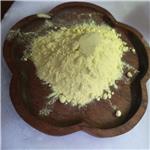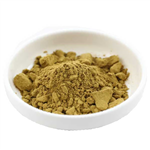| Company Name: |
Proteintech China
|
| Tel: |
027-87531629 |
| Email: |
Proteintech-CN@ptglab.com |
| Products Intro: |
Cas:14113-05-4
ProductName:Royal Jelly acid
|
| Company Name: |
Shanxi Yuning Biotechnology Co., Ltd.
|
| Tel: |
13623677056 |
| Email: |
1639455302@qq.com |
| Products Intro: |
Cas:14113-05-4
ProductName:Royal Jelly Acid
Purity: 99% | Package: 1KG;1KG;25KG
|
- Royal Jelly acid
-

- $148.00 / 500mg
-
2024-11-19
- CAS:14113-05-4
- Min. Order:
- Purity: 98.02%
- Supply Ability: 10g
- Royal Jelly
-

- $0.00 / 1kg
-
2024-06-11
- CAS:8031-67-2
- Min. Order: 1kg
- Purity: 99%
- Supply Ability: 500000kg
- Royal Jelly Powder
-

- $70.00 / 1KG
-
2023-11-30
- CAS:8031-67-2
- Min. Order: 1KG
- Purity: HDA 4%-6.5%HPLC,USP Standard
- Supply Ability: 5Tons
|
| | Royal Jelly Acid Basic information |
| Product Name: | Royal Jelly Acid | | Synonyms: | HYDROXY-2-DECENOIC ACID, (E)-10-(10-HDA)(P);hydroxy-decenouc acid;jelly acid;trans-10-Hydroxy-2-decenoic Acid;(E)-10-hydroxydec-2-enoic acid;Queen been acid;10-HAD,10-hydroxydec-2-enoic acid;OMEGA-HYDROXY C10:1 (2-TRANS) | | CAS: | 14113-05-4 | | MF: | C10H18O3 | | MW: | 186.25 | | EINECS: | 808-119-7 | | Product Categories: | 1 | | Mol File: | 14113-05-4.mol |  |
| | Royal Jelly Acid Chemical Properties |
| Melting point | 64.0 to 68.0 °C | | Boiling point | 339.2±15.0 °C(Predicted) | | density | 1.038±0.06 g/cm3(Predicted) | | storage temp. | under inert gas (nitrogen or Argon) at 2-8°C | | solubility | DMF: 30 mg/ml; DMSO: 30 mg/ml; Ethanol: 20 mg/ml | | form | powder to crystal | | pka | 4.78±0.10(Predicted) | | color | White to Almost white | | LogP | 1.808 (est) | | CAS DataBase Reference | 14113-05-4(CAS DataBase Reference) |
| Safety Statements | 24/25 | | HS Code | 29181990 |
| | Royal Jelly Acid Usage And Synthesis |
| Description | 10-HDA is an unsaturated fatty acid found in royal jelly produced from the hypopharyngeal and mandibular gland secretions of honeybees. 10-HDA has longevity-promoting effects in C. elegans at a concentration of 25 μM. It down-regulates matrix metalloproteinases (MMPs) in rheumatoid arthritis synovial fibroblasts at a concentration of 1.25 nM and inhibits VEGF-induced angiogenesis in HUVECs at 500 μM. 10-HDA also facilitates differentiation of neurons from neural stem/progenitor cells and promotes collagen production by skin fibroblasts at concentrations of 100 μM and 1.5 mM, respectively. | | Uses | 10-Hydroxy-2-decenoic acid has antiseptic, anti-inflammatory, anti-obesity, anti-aging, preventing bone loss and anti-tumour pharmacological effects, with potential therapeutic effects for postmenopausal osteoporosis, as well as benefiting the human gastrointestinal tract[1-3]. | | Definition | ChEBI: (E)-10-hydroxydec-2-enoic acid is an omega-hydroxy amino acid that is 2-decenoic acid in which one of the hydrogens attached to the terminal carbon is replaced by a hydroxy group and in which the C=C double bond has E configuration. It is a component of royal jelly. It has a role as an animal metabolite and a geroprotector. It is an alpha,beta-unsaturated monocarboxylic acid, a straight-chain fatty acid, a hydroxy monounsaturated fatty acid and an omega-hydroxy-medium-chain fatty acid. | | Biological Activity | 10-Hydroxy-2-decenoic acid is an orally available royal jelly component that potently inhibits osteoclastogenesis. It binds to free fatty acid receptor 4 (FFAR4) on osteoclasts which inhibits RANKL (receptor activator of nuclear factor-κB (NF-κB) ligand), thereby attenuating the induction of nuclear factor of activated T cells (NFAT) c1. 10-Hydroxy-2-decenoic acid inhibits bone resorption in ovariectomized mice.
The production of pro-inflammatory cytokines, Interleukin (IL)-8, IL-1β and tumor necrosis factor-alpha (TNF-α) in WiDr cells was modulated by 10-HDA. IL-8 were dramatically declined by 10-HDA at 3 mM, while IL-1β and TNF-α were significantly decreased. 10-HDA increased IL-1ra in a dose manner. NF-κB pathway is primarily in response to prototypical pro-inflammatory cytokines, and NF-κB was reduced after 10-HDA treatment. 10-HDA acted as potent bactericide against animal- or human-specific pathogens, including Staphylococcus aureus, Streptococcus alactolyticus, Staphylococcus intermedius B, Staphylococcus xylosus, Salmonella cholearasuis, Vibro parahaemolyticus and Escherichia coli (hemolytic)[1].
| | References | [1] YUAN-CHANG YANG. 10-hydroxy-2-decenoic acid of royal jelly exhibits bactericide and anti-inflammatory activity in human colon cancer cells.[J]. BMC Complementary and Alternative Medicine, 2018: 202. DOI:10.1186/s12906-018-2267-9.
[2] YOKO HONDA. 10-Hydroxy-2-decenoic Acid, the Major Lipid Component of Royal Jelly, Extends the Lifespan of Caenorhabditis elegans through Dietary Restriction and Target of Rapamycin Signaling.[J]. Journal of Aging Research, 2015, 2015: 425261. DOI:10.1155/2015/425261.
[3] YOSUKE TSUCHIYA. The key royal jelly component 10-hydroxy-2-decenoic acid protects against bone loss by inhibiting NF-κB signaling downstream of FFAR4.[J]. The Journal of Biological Chemistry, 2020, 295 34: 12224-12232. DOI:10.1074/jbc.RA120.013821.
|
| | Royal Jelly Acid Preparation Products And Raw materials |
|